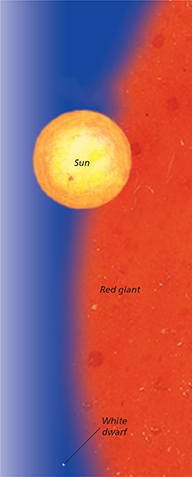The vertical axis of the H-R diagram shows absolute brightness, with the brightest stars at the top and the faintest at the bottom. The absolute brightnesses of stars vary even more than temperature, ranging from about one ten-thousandth to a million times that of the sun!
Main-Sequence Stars
Notice that stars occur only in certain places on the H-R diagram. Most stars are found along a diagonal band running from the bright hot stars on the upper left to the dim cool stars on the lower right. Astronomers call this diagonal band on the H-R diagram the main sequence. About 90% of all stars are found on the main sequence. The sun lies near the middle of this band.
Giants and Dwarfs
In general, two factors determine a star's absolute brightness: its size and its surface temperature. Since an H-R diagram shows a star's absolute brightness and surface temperature, you can use the diagram to estimate the star's size. If you compare two stars at the same temperature, the brighter one must be larger. Similarly, hotter stars are brighter than cooler stars of the same size.
The very bright stars at the upper right of the H-R diagram are called supergiants. Supergiants are much brighter than main-sequence stars of the same temperature. To be so bright, these supergiants must be very large compared with main-sequence stars. In fact, supergiants range in size from 100 to 1000 times the diameter of the sun. Just below the supergiants on the H-R diagram are the giants—large, bright stars that are smaller and fainter than supergiants.
Below the main sequence in the lower part of the H-R diagram are white dwarfs. A white dwarf is the small, dense remains of a low- or medium-mass star. You can see from the diagram that white dwarfs are hot but dimmer than main-sequence stars of the same temperature.
Figure 14 The diameter of a red giant is typically 10–100 times that of the sun and more than 1000 times that of a white dwarf.

Section 26.2 Assessment
Reviewing Concepts
 What method do astronomers use to measure the distances of nearby stars?
What method do astronomers use to measure the distances of nearby stars? What are some common properties used to classify stars?
What are some common properties used to classify stars? Describe the chemical composition of a star like the sun.
Describe the chemical composition of a star like the sun. What is an H-R diagram? How is one useful to an astronomer?
What is an H-R diagram? How is one useful to an astronomer?
Critical Thinking
Applying Concepts What causes the dark lines in a star's spectrum?
Comparing and Contrasting Describe the locations of giants, supergiants, and white dwarfs on an H-R diagram.
Math Practice
The bright star Spica is located about kilometers from Earth. How many light-years is this?
Betelgeuse is about 427 light-years from Earth. How many kilometers is this?




